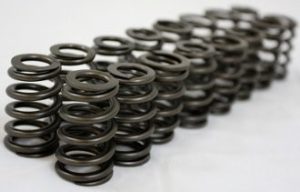 Knowing how to theoretically determine spring load is an important aspect of the manufacturing process. Without proper spring attention to the load output, you may not get the right spring for your specific application. There are several different types of springs that are used in a wide variety of products, and the springs will have different considerations that need to be taken into account while determining load. Here are some general guidelines.
Knowing how to theoretically determine spring load is an important aspect of the manufacturing process. Without proper spring attention to the load output, you may not get the right spring for your specific application. There are several different types of springs that are used in a wide variety of products, and the springs will have different considerations that need to be taken into account while determining load. Here are some general guidelines.
Information You’ll Need: Helical Compression Springs
To determine the theoretical load of helical compression springs, you’ll need to know the wire diameter, outer diameter, free length, and number of coils. You’ll also need to choose an end type, such as closed and squared where the last coil touches the previous coil, closed and grounded where the last coil is flat, double closed ends, where the last two coils on the ends are closed in order to stabilize it or assist in reducing tangling, or open ends where the ends have space between them.
Information You’ll Need: Tension and Extension Springs
For tension and extension springs, you’ll need to know the measurements of the wire diameter, outer diameter, length inside the hook, length of the body, and the type of hook used. Your hook options are machine hook, where the hook is made out of the coils at the end, cross-over center hook, where the ends are bent straight down the center and then loops around, side hooks, which are bent outwards from the spring’s side, no hooks, where the ends act as threading when you want to insert a bolt in the middle, or extended hooks, which extends the hook’s length for added reach.
Information You’ll Need: Torsion Springs
The dimensions you’ll need to gather for torsion springs are the wire diameter, outer diameter, number of coils, length of legs 1 and 2, and any bends or shapes on the legs.
How to Measure the Dimensions
To get accurate dimensions to determine spring load, use calipers to measure the spring. Have the calipers in one hand and the base of the spring in the other. To calculate the outside diameter, measure the largest dimension on the outside of the last coil. For inside diameter, place the teeth of the caliper on the inside diameter. For free length, put the calipers on the entire length of an uncompressed spring. For wire size, put the calipers in the center of the spring on the wire. In order to count all the coils, begin at one end just beside where the wire’s been cut, and make sure all portions of the coil are counted. For simplicity in determining accuracy of less than a coil utilize the numbers of a clock where for example half a coil would be 6/12ths and a quarter coil would be 3/12ths. Some spring calculators may require this information in 10ths of a coil instead of 12ths.
How to Use the Information
Now that you’ve collected all the necessary dimensions for your spring, you can determine spring load by using a spring calculator if you have previous experience with one, or by going to an expert. Because the calculations must be exact to get an accurate gauge, it’s often best to allow a spring expert, such as through your manufacturer, to take care of measuring your spring load. Your manufacturer will have the experience necessary to properly determine its load.
Belt Tensioner Spring
Learn How We Helped an Automative Parts Manufacturer
Reduce Spring Cost by 20%
